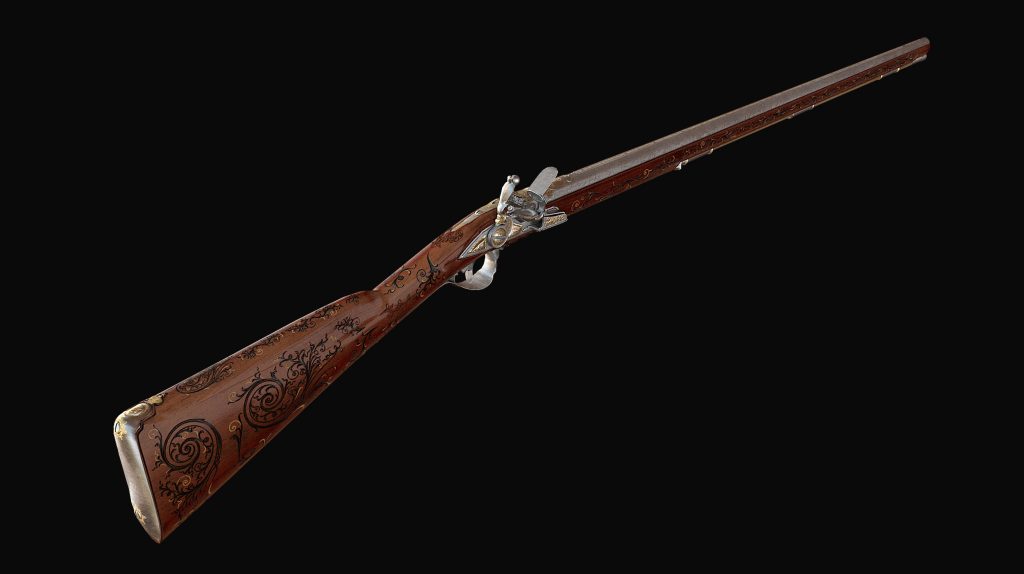Specifications
Carbine caliber – 12.7 mm, carbine barrel length – 0.77 m, carbine total length – 1.17 m, carbine weight – 1.94 kg.
Operating principle
The true flintlock mechanism came to be used in firearms as far back as the first half of the 16th century, in the Middle East. The wheellock was likewise in common use at the time. In Europe the lock first gained its popularity in Spain. The design features enabled wide application of the flintlock, whose benefits helped it quickly replace the wheellock and the matchlock. The flintlock continued to be mounted to all weapon types for two centuries, until emergence of the original caplocks and cartridges.
The gunpowder is ignited in a flintlock by a spark created when a cocked hammer with a small piece of flint strikes a special steel plate called the frizzen. The spark ignites the priming powder on the pan. After that the main charge is ignited via a dedicated priming hole, releasing the energy for a shot.
To fire a shot you need to half-cock the hammer. Then open the pan cavity to place gunpowder therein. Close the loaded pan and full-cock the hammer. The gun is loaded with a quantity of gunpowder measured by a dedicated dispenser. Use a wad to compact the powder, load a bullet, limit it with another wad, and thoroughly tamp it all with a long rod. The flint firmly held in place by the hammer jaws strikes the pan cover to produce a spark. It ignites the priming powder that, in turn, ignites the main powder charge required to fire a shot.
History of the specimen
In late 17th century, replacing of all matchlock weapons for flintlock mechanisms commenced. That special mechanism marked a new era in the history of firearms production. After the flintlock came into use, firearms grew very popular and widely accepted by the people.
An original flintlock carbine is a true jewel throughout the imperial period of weapons production. Such weapons were produced to commemorate Empress Catherine the Great’s historic visit to the Tula Arms Factory in 1775.
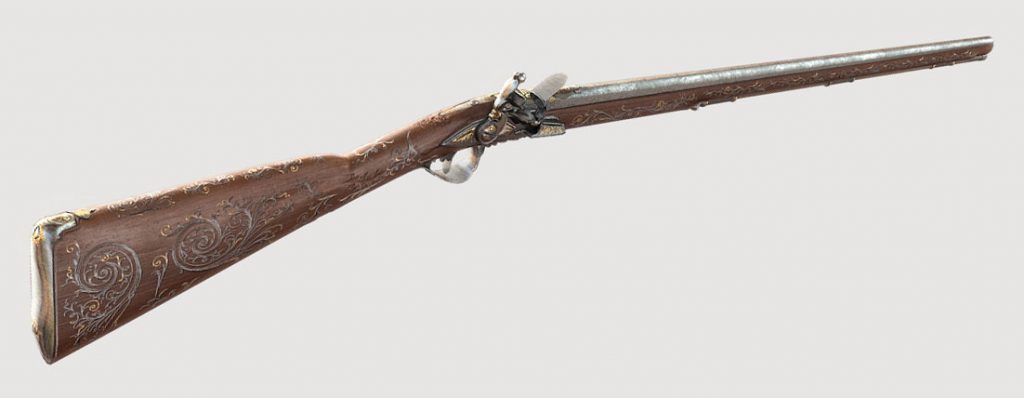
The original carbine design comprises a unique stock made of noble wood species and covered with exquisite ornaments elegantly inlaid in gold and silver. The hammer base has a special lining shaped as an unidentified animal. The carbine main elements, including true flintlock mechanism, various decorative screws, a dedicated trigger guard and breech end of the barrel, have additionally been garnished by embossed golden flower ornaments.
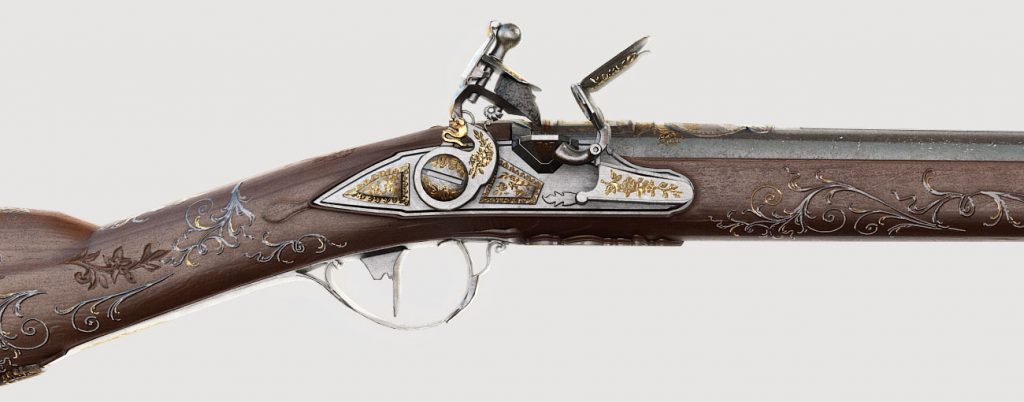
The breech end of the barrel has a special oval projection with an original golden monogram of Empress Catherine. The Tula craftsmen decorated the monogram with custom-made steel “diamonds.”
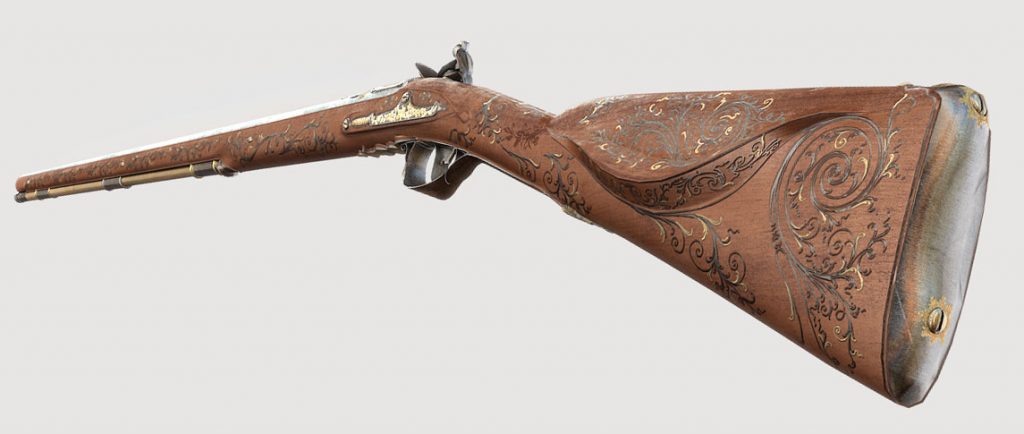
The carbine external surfaces made of special metal have been blued. All the required inscriptions are embossed in gold. A unique rod made of expensive wood species has a dedicated black horn-wrought head on top.

Development
Europe started using flintlocks in arms production as far back as 1504. Spanish artisans were the first to apply this type of gun smithing. Following prolonged use in gun smithing, flintlocks quickly spread across Europe. The system offered its own advantages and drawbacks.
The mechanism basic functioning principle relies on a definite ignition sequence. The priming powder is ignited by a spark produced when the flint piece strikes a special metal plate. The system enables to completely rule out the use of a match as the igniter. The simplification and maximum efficiency of the system became widely used in gun smithing of the time.
The initial attempts of applying the system in weapon production in our country encountered some distrust, that soon gave way to complete support. Combined production methods were used in opening stages of flintlock adoption. However, that lasted for a short while. The flintlock system quickly gained the reputation of a high-quality and reliable mechanism. German gunsmiths played the most crucial role in flintlock proliferation. The flintlock was used in Russia for some 150 years.
There are two major lines for flintlock evolution: the Mediterranean and the Baltic paths, respectively. The Mediterranean path of flintlock development stands apart for its special design with small dimensions and specified unit weight. This school was developing in the Western Europe. The Baltic lock system featured oblong shape that accounted for larger dimensions. Both schools had their own distinctions, comprised by diverse flintlock variations and modifications. Marin le Bourgeoys, a most prominent gunsmith of the time, managed to incorporate both systems and create a unique flintlock that enjoyed highest demand in the next three centuries.
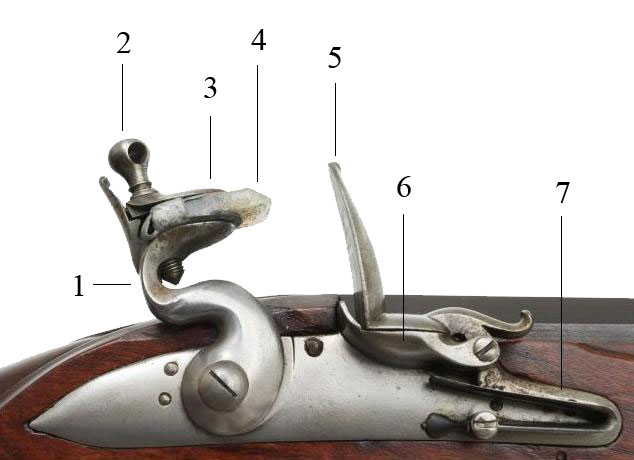
French flintlock
1 — hammer
2 — hammer screw
3 — top jaw
4 — flint
5 — cover (frizzen)
6 — pan
7 — frizzen spring
Use
The unique flintlock was used to manufacture all kinds of arms, for combat and hunting purposes. This is why this type of weapon did not differ drastically by design. Hunting weapons were most popular in the reign of Catherine the Great since she adored game hunting and widely advocated the hunting rules.
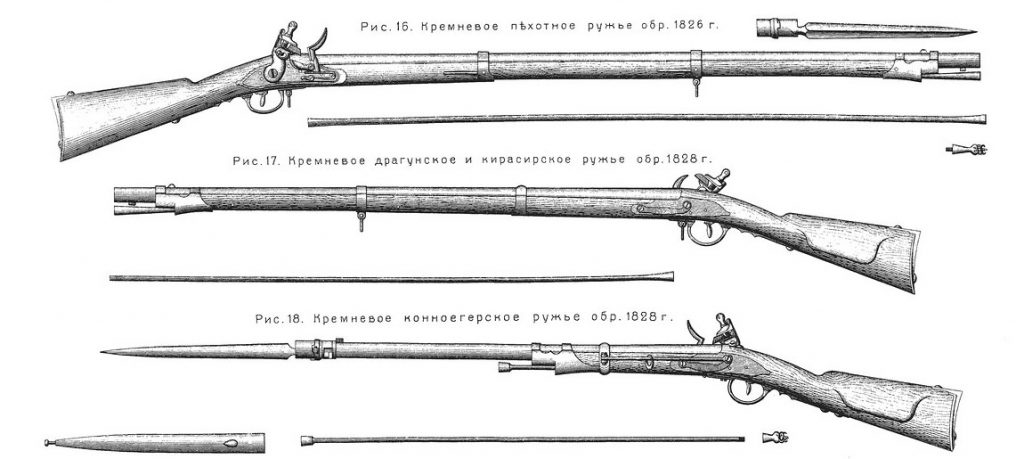
As ordered by the empress, the most promising and sophisticated Tula gunsmiths produced original specimens of hunting weapons. Such models distinguished for superb finishing ornaments, unmatched specifications and design that was perfect for the time. Tula gunsmiths used the true flintlock in the making of hunting weapons.
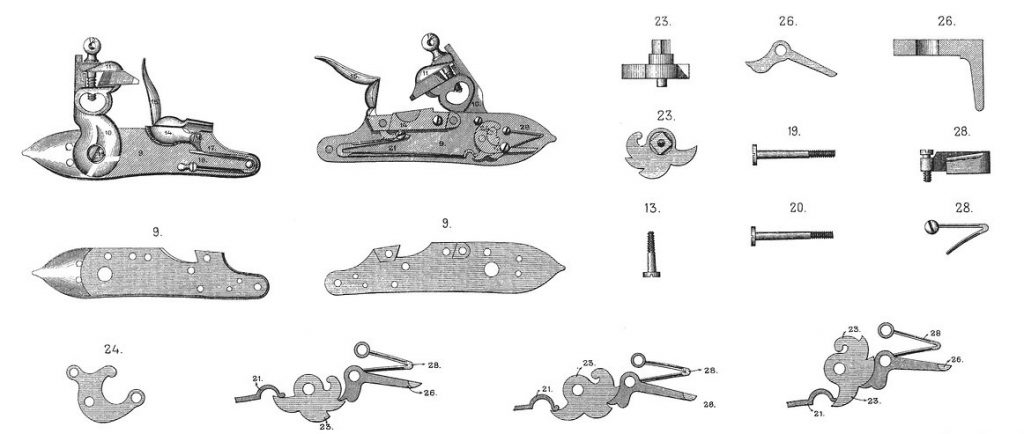
The best gunsmiths of the Tula arms factory appeared to be the major makers of the flintlocks at the start of the 18th century. Such weapon models lacked the luxurious trimming of the imperial specimens, but offered maximum reliability and functionality. Tremendous experience in making of the original weapons enabled then-existing artisans to permanently improve the skills and manufacture higher quality flintlock items.
In 1812-1814, the gunsmiths of Tula manufactured and fully restored more than 500,000 units of original flintlock weapons. Supreme ease of manufacture was a specific feature of the flintlock at the time. This very feature made the weapon type popular to a known extent and promoted its widespread use in various production types. Higher reloading rate that enabled 2-3 shots per minute – quite a benchmark then – stood as another feature of the flintlock. In some cases the infantry achieved 6-7 shots per minute in combat, a smashing figure. Such rate of fire proceeded from dedicated modifications in the design of the gun and the true flintlock.
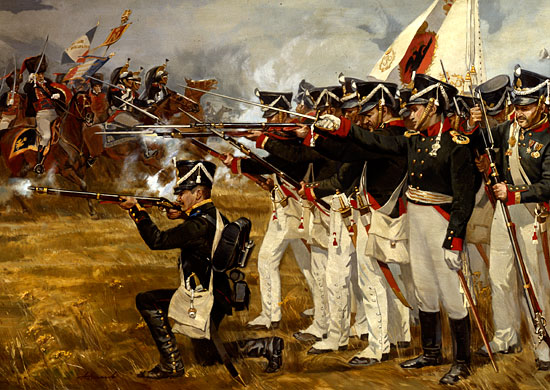
Flintlock major drawbacks
The need for regular and thorough care was the key drawback of the flintlock system. The flintlock ensured the required firing rate in case of due attention and care. Misfires occurred at times, caused by poorly fixed or creaky flint. Ignition problems arose due to damp powder which could not be stored fire-ready for long. Even a fully workable flintlock could give some 15 various misfires per 100 shots fired. The rest of the drawbacks in this ignition system were inherited from the previous developments of the gunsmiths. An approximate quantity of powder in the charge resulted in an irregular shot that could not guarantee high precision and range. A plume of smoke after the firing dramatically reduced the shooter’s visibility in preparations for the next shot.
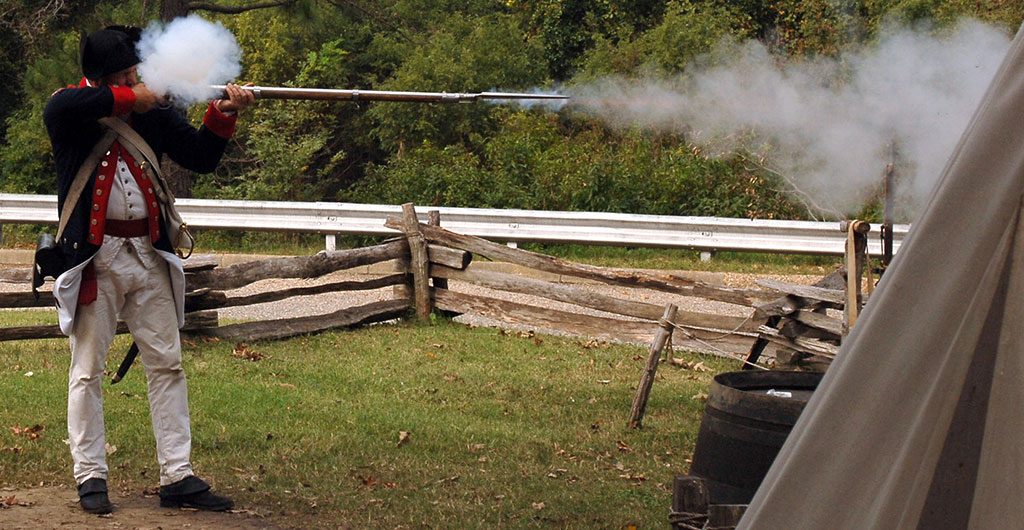 The weapons with true flintlock was widely used worldwide until early 19th century. This type of weapons was in private use for a while thereafter, since in Russia flintlock rifles were manufactured until 1884. Nowadays, an original flintlock weapon is a genuine rare collector’s item. In some countries replicas of single-shot flintlock rifles are engaged in various entertaining events. However, there are instances when flintlock guns are still used in real life. For example, by some African tribes, in some places to maintain traditions, in others due to lack of other weapons for hunting.
The weapons with true flintlock was widely used worldwide until early 19th century. This type of weapons was in private use for a while thereafter, since in Russia flintlock rifles were manufactured until 1884. Nowadays, an original flintlock weapon is a genuine rare collector’s item. In some countries replicas of single-shot flintlock rifles are engaged in various entertaining events. However, there are instances when flintlock guns are still used in real life. For example, by some African tribes, in some places to maintain traditions, in others due to lack of other weapons for hunting.

